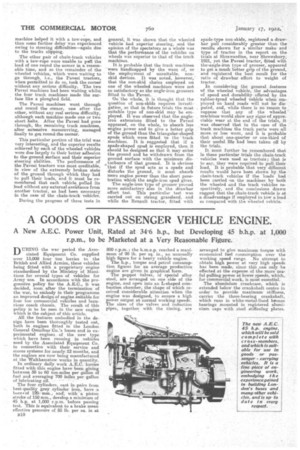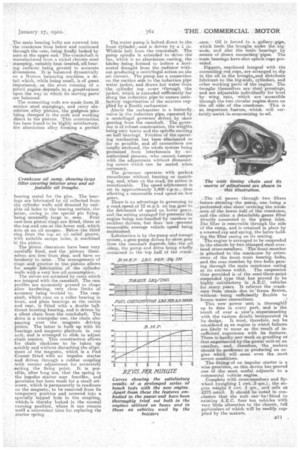A GOODS OR PASSENGER VEHICLE ENGINE.
Page 10

Page 11

If you've noticed an error in this article please click here to report it so we can fix it.
A New A.E.C. Power Unit, Rated at 34•6 h.p., but Developing 45 b.h.p. at 1,000 r.p.m., to be Marketed at a Very Reasonable Figure.
URING the war period the Asso ciated Equipment Co. supplied over 13,000 four ton lorries to the British and Allied Armies, these vehicles being fitted with a proprietary engine standardized by the Ministry of Munitions for several types of vehicles for Army use. In accordance with the progressive policy for the A.E.C., it was decided, soon after the termination of the war, to embody in their programme an improved design of engine suitable lotfour ton commercial vehicles and luxurious coach chassis. The result of this policy is to be seen in the new engine which is the subject of this article. All the features embodied in the design have been thoroughly tested out, both in eugines fitted in the London General Omnibus Co.'s buses and in experimental engines of the new type which have been running in vehicles used by the Associated Equipment Co. in connection with their service and stores systems for nearly-i2 months, and the engines are now being manufactured at the Walthamstow works in quantity. In ordinary daily work A.E.C. lorries fitted with this engine have been giving between 50 to 60 ton-miles per gallon of fuel and averaging 700 Liles per gallon of lubricating oil.
The four cylinders, cast in pairs from best-quality grey cylinder iron, have a bore eof 120emm., and, with 'a piston stroke of 150 mm., develop a minimum of 45 h.p. at 1,000 r.p.m. before passing test. This is equivalent to a brake mean effective pressure of 85 lb. per so. in at
B10 800 r.p.m.. the b.m.e.p. reached a maximum of 96 lb. per sq. in., en unusually high figure for a heavy vehicle engine. The h.p., torque and petrol consumption figures for an average production engine are given in graphical form. The poppet Valves, of special alloy steel, are arranged on one side of the engine, and open into an L-shaped combustion chamber, the shape of which received considerable attention when the engine was designed, to ensure a high power output. at normal working speeds. The sizes of the valves and induction pipes, together with the timing, are arranged to give maximum torque with economical fuel consumption over the working speed range. No attempt to obtain high power at very high speeds has been made, since this can only he effected at the expense of the more UP:ul pulling power at lower speeds, which, for commercial work, is most essential. The aluminium crankcase, which is extended below the crankshaft centre in order to provide maximumstiffness, carries the three-bearing crankshaft, which runs in white-metal-lined bsonze bearings mounted in registered aluminium caps with steel stiffening plates.
The main bearing bolts are screwed into the crankcase from below and continued through the case, being finally looked by nuts at the upper end.The .crankshaft is manufactured from a nickel chrome steel stamping, suitably heat treated, all bearing surfaces .being ground to accurate dimensions. It is balanced dynamically on a Norton balancing machine, a detail which, while being small, is of great importance, as the even running of a petrol engine depends to a greatsextent upon the way in which its moving parts. are balanced.
The connecting rods are made from H section steel stampings, and carry aluminium alloy pistons, the gudgeon pins being clamped in the rods and working direct in the pistons. This construction has been found to be highly satisfactory, the aluminium alloy forming a perfect
bearing metal for the pins. The bearings are lubricated by oil collected from the cylinder walls and directed by suitable oil holes to the bearing surface, the latter, owing to the special pin fixing, being unusually large in area. Four cast-iron piston rings. are •fitted, three at the top and one at the Ismer end, which acts as an oil scraper. Below the third ring from the to an oil relief groove, with suitable escape holes, is machined hi the piston. The piston clearances have been very carefully fixed, and the pistons them' selves are free from slap, and have no tendency to seize. The arrangement of rings and grooves in the pistons allows for ample lubrication of the cylinder wails with a very low oil consumption.
The valves are actuated by cams which are integral with the camshaft. The cam profiles are accurately ground to shape after hardening, very close limits of hecuracy being worked -to. The camshaft, which runs on a roller bearing in front, and plain bearings at the centre and rear, is fitted with a double ballthrust locating bearing, and is driven by a silent chain from the crankshaft. The drive is a triangular one, the chain also passing over the magneto driving pinion. The latter is built up with its bearings and magneto platform in one unit, and is arranged to slide to adjust chain tension. This construction allows for chain slackness to be taken up quickly and without disturbing the alignment of the magneto, which is a Peel Conner fitted with an impulse starter and driven through a rubber coupling with vernier adjustment for accurately (setting the firing point. It is possible, after long use, that the spring in the impulse starter may fractiire and provision has.been made for a small setscrew, which is permanently in readiness on the magneto. to be removed from its temporary position and screwed into A specially tapped hole in the coupling, which+ is thereby locked in the normal running position, where it can remain until a convenient time for replacing the starter spring. The water pump is bolted direct to the front cylinder) 'and is driven by a 1 in. Whittle belt from the crankshaft. The pump spindle is extended to drivethe fan, which is an aluminium casting, the blades -being forined to induce a horizontal draught from the radiator without producing a centrifugal action on the air current. The pump has a connection on the suction side to the induction pipe water jacket, and draws hot water from the. -cylinder top cover 'through the jacket, which is extended sufficiently far along the induction pipe to ensure. satisfactory vaporization of the mixture supplied by 4 Zenith carburetter. Above the carburetter is a butterfly valve in the induction pipe,. operated by a centrifugal governor -driven by skew gearing from the camshaft.. The governor is of robust construction, the weights being very heavy and thespindle running on ball bearings. Friction of the.eperating mechanism has been -eliminated so far as possible, and all connections are totally -enclosed, the whole System being protected from interference by unauthorized persons, -who cannot tamper with the adjustment without dismounting covers which can be sealed when necessary. The governor operate-s with perfect smoothness without hunting or snatching, and, when on the road, its action is unnoticeable. The speed adjtistanent is set to approximately 1,400 r.p.m., thus allowing a reasonable road speed on low gears.
There is no advantage in governing to a road.speedof 12 m.p.h. on top gear to the detriment of speed on lower gears, and the setting arranged for prevents the engine being. mis-handled by careless or reckless drivers, but does .not prevent reasonable average vehicle speed being maintained.
Lubrication is by thepump and trough s.ystern, agear pump driven by skew gear from the camshaft depends into the oil sffinp, the purep and drive being wholly contained in the top jEalf of the crank case. Oil is forced to a gallery pipe, which feeds the troughs under the big. 'ends, and also the -main -bearings by means of direct connecting pipes. The main bearings have alsosplash cups provided.
Dippers, machined integral with the connecting rod cups,. arearranged to dip in the oil in the trougha6and distribute lubricant to the big-ends, Cylinders, and other working parts of the engine. The troughs themselves are steel pressings, and are adjustable individually for level by wing nuts, Which are • accessible through the two circular engine -doors on the off side of the crankcase. This is an important feature, which will car• tainly -assist in-economizing in .oil.
The oil passes through two filters before entering the pump, one being a perforated zinc sheet covering the whole area of the lower half, of the crankcase; -and the other a detachable gauze filter directly connected to the pump inlet. The filter is removable through the side of the sump, and is retained in place by a screwed cap and spring, the latter holding the filter casing on its seating. The engine is arranged to be suspended -in the ehasais by two stamped steel overhead cross-members. The front member is attached to -the crankcase by extensions of the front main bearing bolts, and the rear member-by two bolts passing through the main crankcase casing at its extreme width. The suspension thus provided is -of the semi-three-point suspended type that has proved to be highly satisfactory in A.E.C. vehicles for many years. It relieves the crankcase from strain due to frame flexion, without being sufficiently flexible to loosen water connections.
This new power unit is thoroughly up to date in every part, and is the result of over e-year's experimenting with the various details incorporated in; its design. It must, therefore, not be coi.sidered as an engine in which failures are likely to occur as the result of insufficient experience with its features. There is hardly any work so gruelling as that experienced by the power unit on an omnibus, and, therefore, the .,makers should he proficient. in producing an engine which will _meet even the most severe conditions.
The fitting of an impulse starter is a wise provision, .as this device has proved one of the most useful adjuncts to a commercial vehicle engine. Complete with cross-members and flywheel (weighing 1 cwt. .3 qrs.), the engine weighs 8 cwt. 3 qrs., and sells ati £275 retail. It should be noted in conclusion that the unit can' be fitted to existing A.E.C. four ton vehicles with very little alteration to the chassis, full particulars of which will be readily supplied by the makers.




























